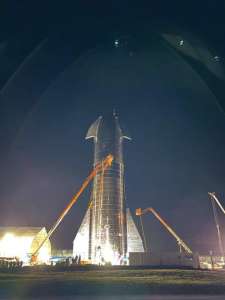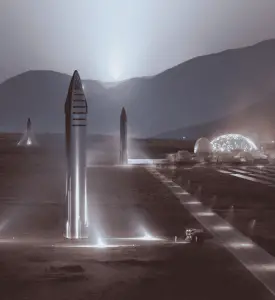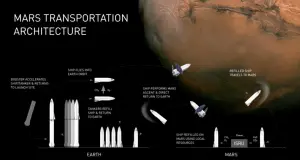We have been speculating about the possibilities of the existence of other forms of life in this universe. No proof has been found yet to confirm these claims. But talking about possibilities, there may be a possibility that we might be the one and only planet with intelligent life. Then Why Elon Musk Wants to Go to Mars?, According to Elon, it is essential we do whatever it takes to preserve consciousness, he fears which might be a unique trait of the human species. He fears that the loss of consciousness might be the greatest of all the losses ever in the history of everything.
Why Elon Musk Wants to Go to Mars
As a solution to this problem, he found out that the key lies in colonizing another planet, Thus making us resilient against the failure of our mono planet residency. Elon Musk again made headlines when at the 67th annual International Astronautical Congress in Guadalajara, Mexico unveiling his SpaceX’s plan. His plans for the year 2024 for tripping to Mars will involve spaceships carrying hundreds of passengers to the Red Planet and returning back to Earth and repeat the drill. He is planning to launch 3 crafts daily with an estimated relocation of around a million people to Mars by the year 2050. To support the life of so many relocated people, a total of 1000 Starships will also carry tones of food, water, building materials, tools, medical equipment, solar panels and life support systems.

Musk is planning to be the hero who saves the Human race by relocating humans and colonizing them on Mars building a civilization there. These sweet-sounding plans require all the gears and gadgets that look straight out of a sci-fi movie and has to be cheap enough to serve the purpose. As sweet as this dream sounds, making it a reality will need pockets deeper than the Mariana trench, costing roughly more than $10 billion today.
What if the SpaceX’s Interplanetary Transportation becomes possible?
Elon Musk estimates a cost of $200,000 per passenger to make the relocation happen. He stated that for those who cany afford it will have the option of loans available for the same.
Musk stated that accomplishing these cost cuts will require the usage of new technology: gargantuan, reusable rockets, carbon fiber fuel tanks, ultra-powered engines, lighter materials and reusable technology.


Elon Musk/SpaceX plans to Go to Mars
Elon Musk is planning to send 100+ passengers along aboard a huge crew craft on the top of an enormous new rocket. Numerous Raptor engines called the Super Heavy push the whole spacecraft now called the Starship (earlier called the Falcon Rocket) gunning in the course of the upper limits of the atmosphere at tens of thousands of miles per hour. Once it attains orbit, the first stage booster is dropped back to Earth, which traces its path back to Cape Canaveral, which is the launching location. Followed by a few unknown restorations, another spaceship on top is attached. In this phase, it is full of fuel without any passengers and sets ahead to meet your spaceship to be refueled while in orbit.
This process is repeated a couple of times until your ship is topped off with fuel to complete its voyage to Mars. Talking about fuel, the selection of the right propellant is a major factor. Methane/Oxygen also known as deep cryo methalox is chosen over Kerolox or Hydrolox because of its ease of production even on Mars. To complete the journey six vacuum-optimized engines, it launches your ship to about 19,014 mph, taking a time of just 100 days to reach Mars. When entering Mars’ scant atmosphere, heat shields on the ship will generate low friction helping in braking which will assist the primary braking mechanism called the supersonic retro propulsion. It fires engines on Mars’ land same as SpaceX does in its Falcon 9 rockets. There is a difference though that the ship is traveling much faster and is many times heavier. Mars’ gravity is about one-third that of Earth’s which makes all this a lot easier.

The initial temporary habitats will be the Starships themselves. To enable them to serve this function as well they are equipped with life support systems. The proposed landing zone is located at a shy of 40-degree latitude to harness max solar power, and have warm temperatures and proximity to massive subsurface water/ice sources. Claims made by SpaceX state that the propellant plant has a capacity of mining and purifying water at a rate of 1 ton per day. It is expected that sufficient electric power based on fission reactors and solar and wind energy-based models will be made available.

As Musk states at the beginning of his speech during the event that there can be two possibilities for the future of the human race –
- We continue to dwell on Earth as a forever evolving species.
- The human race and all life on Earth may succumb to extinction.
While all this may sound like directly out of a sci-fi movie there still are several complications involved that are yet to be solved. To give a brief idea one of them is the effect of space radiation exposure over extended periods. If humans stay within the low earth orbit, or on the moon or the international space station they are still very much protected from the harmful space radiation because of the Earth’s magnetic field. On the other hand, Mars lacks its own magnetic field and very little protection from cosmic radiations is provided by its thin atmosphere. Another one may be that human intervention may introduce microbiology to Mars which hay harm or can even kill any life on the red planet.
NASA’s mission to Mars
Not only Musk but NASA also has its target year of 2030 to colonize Mars. There are several reasons why going to Mars could a breakthrough for Science. Man’s quest to learn the secret of life’s origin is driving them towards the red planet in the hope to learn more and more about the rise and fall of potential life-supporting environments.
Mars may hold a lot of secrets as it is claimed that it was not always the desert we see it now as. Its empty lakes and channels prove that once the lands had water flowing on its surface, which further indicates the presence of a thicker atmosphere indicating the possibility of life. This shows Mars as a failed planet but scientists predict that Mars can still be hostile to humans. Whatever advancements may be seen will surely benefit NASA, SpaceX and other space agencies globally.
While in an attempt to further prove the world the seriousness of his desire to reach Mars, SpaceX has planned to take tourists to the moon for a week-long vacation in 2023. One of the tourists is the Japanese billionaire Yusaku Maezawa who will be flying off in the Starship.
Before all this, in 2001 Musk presented a concept called “Mars Oasis”, in which he landed a miniature greenhouse with seeds with dehydrated gels on Mars to test the growth of plants there. After finalizing all the budget he realized it would be hugely expensive without a step forward in rocket technology. Elon traveled to Moscow in 2001, October with his team to purchase refurbished ICBMs needed to transport the envisioned payloads to Mars.
SpaceX failures and achievements
Apart from all this bamboozle, the headlines, the spotlight and success, there have been many failures as well for the SpaceX program. This makes it an even more inspiring story.
- One of the first accidents was Thursday’s launchpad explosion that took place in Florida. In the year 2006, the first attempt to launch the first SpaceX failed at 33 seconds after the link off. On post-inspection, it was revealed that the cause was a rusty nut. A video was also recovered from the rocket that recorded till the moment before the explosion providing a blurry view facing down from the rocket.
- Next, it occurred in 2007, ending its chance of establishing credibility. The engine malfunctioned shutting down prematurely failing the rocket to reach orbit.
- In the following year, 2008, a stunt to ferry the ashes of the Star Trek actor James “Scotty” Doohan into space failed miserably when he payload ended into the sea. The video captured by on craft cameras shows the moment of separation and collision of two of the rocket stages, resulting the craft to spin in an uncontrolled manner. This time the payload included its first delivery on behalf of NASA. This was one of the most damaging accidents for SpaceX, but luckily just a day after the crash billionaire Peter Theil saved the company as an outside investor.
- After a few years that went as planned then again in 2015 a SpaceX rocket vaporized shortly after its launch. It was on June 28th which is also the birthday of SpaceX Founder Elon Musk. This rocket had 2 payloads onboard for NASA headed towards the International Space Station. NASA has used this situation to further negotiate substantial discounts on its SpaceX contracts.
After these many mishaps, SpaceX decided not to let any other accident holdback their success. The SpaceX rocket soon made a vertical return to the ground, which was a big success. But again in the year, 2016 SpaceX rocket was lost owing to a blast during fueling before launch.
Even after these failures, one thing constant was Elon’s efforts to make his dream come true. So many setbacks can’t hold him back from doing what he loved. Elon is an example to the world that constant efforts and a clear vision always succeed no matter how many odds we have to face. Let’s look at some of the achievements that SpaceX has to its name.
SpaceX is the first private company to have achieved the following:
- By March 2020, the single first-stage booster has been used at most 5 times.
- To send a liquid-fueled rocket that has reached orbit.
- To have taken a commercial satellite to orbit.
- To successfully launch, orbit, and recover a spacecraft.
- To have sent its spacecraft to the International Space Station.
- To have sent a satellite into geosynchronous orbit.
- To land the first stage of an orbital on land and on an ocean platform.
- To relaunch and land a used orbital rocket stage.
- To complete a flyback and recovery of a payload fairing
- To reflight a commercial cargo spacecraft.
- To send an object into a heliocentric orbit.
- To have sent a human-rated spacecraft to space.
- To achieve autonomous docking of a spacecraft to the International Space Station.
- To use a full-flow staged combustion cycle engine in a free-flying vehicle.
- To reuse a payload fairing.
- To accomplish the task of sending humans into orbit.
- To have sent humans to the International Space Station.



